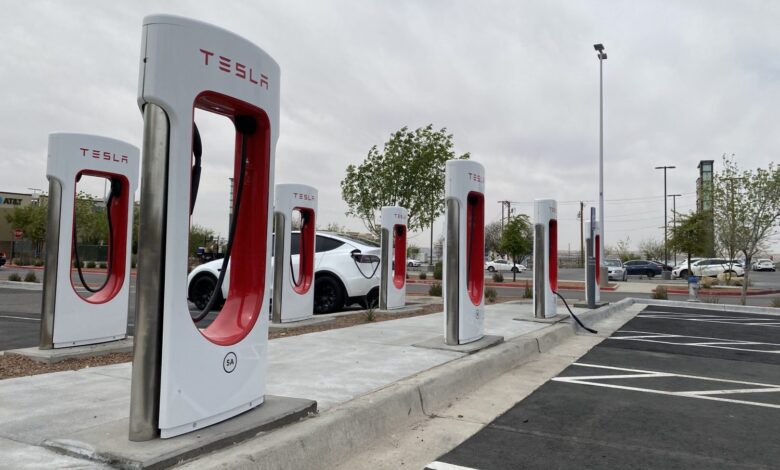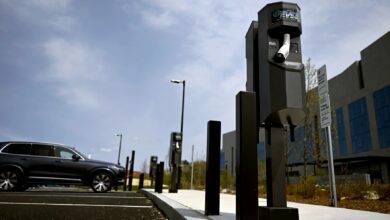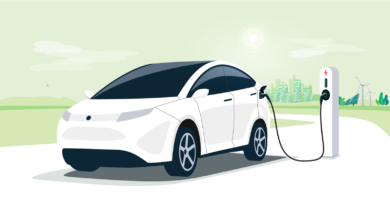El Paso Electric offers New Mexicans incentives to drive EVs

El Paso Electric will soon offer incentives to nudge some of its customers to shift toward electric transportation and ditch gas-powered vehicles.
If you want an electric bicycle, EPE will cover half of the cost. Need an electric vehicle charger in your home to juice up your car? The utility will pay for that, too.
But there’s a catch: You have to live in New Mexico. Will similar EV-related incentives be offered in El Paso? At some point, utility officials said.
Utility regulators in New Mexico recently approved El Paso Electric’s batch of incentives to encourage more customers to purchase electric vehicles. The three-year, $12 million plan will take effect later this year following regulatory approval.
El Paso Electric also wants to ensure customers with electric vehicles charge overnight to avoid overtaxing the grid during daytime hours when power demand is higher.
“New Mexico is very supportive of expanding transportation electrification,” Angie Rodriguez, the utility’s supervisor in charge of EV programs, told El Paso Matters.
EPE serves about 100,000 customers in its New Mexico service territory that spans from Las Cruces up to Hatch. Each electric utility in New Mexico is mandated by state law to craft a so-called transportation electrification plan that details how they’ll incentivize electric transport for customers of all income levels.
Rodriguez said EPE’s goal for its expanded electric vehicle plan “is to increase EV adoption in our New Mexico service territory, support the development of charging infrastructure to ensure that it’s equitable and it’s accessible to all of our customers.”
“And also to help us shift EV loads to off-peak hours, when we have capacity available on the grid,” she added.
Meanwhile, El Paso Electric is trying to win approval from Texas utility regulators for a somewhat similar plan designed to encourage more El Pasoans to drive EVs. The Texas EV plan – an $11.3 million batch of customer incentives – is voluntary and not required by law in the state.
The future of the plan and whether the Public Utility Commission of Texas will approve it isn’t clear.
EPE won approval for its first electric transportation plan for New Mexico in 2021, a two-year program with a budget of $1.2 million that included some rebates and pilot programs and dedicated some money to educate customers about EVs.
But after studying customers’ reactions, El Paso Electric executives decided the program’s incentives needed to be bigger to move the needle for consumers. The utility boosted the budget several times over, devoting $11.8 million to fund the new suite of electrification programs through 2026.
“We listened to our customers, and we found out that they needed greater incentives than what we used to offer in the previous plan,” Rodriguez said. “And a lot of them wanted to have EV chargers on their property.”
Local electric vehicle owners told El Paso Matters that charging their EVs isn’t too burdensome and that the costs of some EV models have declined.
“Charging at home is extremely convenient, and is much less expensive than paying to fill up an equal-sized vehicle,” said Isaac Harder, who late last year purchased a Ford Lightning pickup truck, the electric version of a Ford F-150. “I estimate I save about $200 in fuel costs.”
For Vanessa Aguilar, who said she purchased an electric SUV last October, the extra electricity used to charge her vehicle has added about $30 to her monthly power bill.
“I did pay an electrician to install a high power charger at my house, but feel the added convenience was worth every penny,” she said.
About El Paso Electric’s rebates
The new electrification plan is a constellation of programs and rebates for New Mexico customers. One of the major elements is a $4,000 rebate for 50 low-income customers who purchase an EV. “Low-income” refers to ratepayers who earn up to double the federal poverty level, or about $30,000 in annual income for an individual.
“Equity is very important to us, because we feel that the market, the early adopters have kind of bought electric cars already, right? And now we’re trying to move it from the early adopters to mass market adoption,” Rodriguez said.
Buyers can combine the $4,000 rebate from EPE with a $3,000 incentive offered by the state of New Mexico, plus a $7,500 credit from the federal government. As of the end of March, U.S. buyers on average paid just over $52,000 for a new electric vehicle, compared with about $47,000 for new gas-powered vehicles sold last month, according to Cox Automotive.
And in order to charge the electric vehicles, El Paso Electric will rebate up to $500 to 260 customers who purchase a Level 2 EV charger for their home, which typically retail for around $500 to $700, Rodriguez said. Level 2 chargers are the most common EV chargers today, and they can provide about 25 miles of driving range per hour of charging. EPE will also rebate up to $1,300 to customers to cover charger installation costs.
Rodriguez, who owns a Tesla electric vehicle, said she charges her car almost entirely at home and rarely uses public charging stations. Still, Texas’ EV plan calls for installing an EV charging station every 50 miles along major highways, including Interstate 10. The goal is to alleviate the so-called range anxiety – or the fear of your EV running out of juice far away from a charging station – that scares off some customers from transitioning to an EV.
“Charging has been relatively easy and cheap,” said Steven Arrellano, who said he bought an EV last year. “But options to charge away from my home are still too few.”

Andrew Meadville said he drives a plug-in hybrid electric vehicle that can go about 50 miles on its electric battery without using any gasoline.
“We charge at home every night which saves us a lot of money and only buy gasoline on trips,” he said. “We aren’t comfortable going full EV due to the charging infrastructure when traveling.”
EPE’s electric vehicle plan also includes a program offering rebates for 110 customers that pays for half of the cost of a new electric bicycle up to $900. For customers considered low-income, EPE will pay out 30 rebates worth as much as $1,300 for an e-bike.
The number of rebates that EPE is offering is relatively small for a utility with hundreds of thousands of customers.
The utility’s leaders, however, say the idea is to expand the EV program at a relatively low price tag, and study whether customers use all of the available rebates and programs by the end of 2026.
EPE’s residential customers in New Mexico will see their bills increase by about 62 cents per month to fund the EV-related incentive programs.
Electric vehicle sales growth
El Paso Electric executives said they have good reason to invest in electrified transportation in New Mexico and eventually in Texas.
For one, consumers are already shifting to EVs at an accelerating pace – although the growth of EV sales in the U.S. has slowed over the last year. More than 4,300 electric vehicles are registered in El Paso County, a figure EPE estimates will grow to 8,854 locally-registered EVs by the end of 2025.
By comparison, roughly 700,000 total vehicles are registered in the El Paso area, according to the Texas Department of Transportation.
So even though EVs still make up a tiny share of the total vehicles on the road in El Paso, EPE wants to get ahead of the curve before more are on the road and ensure customers are used to charging their cars overnight and usually at home.
Otherwise, according to the utility, if more people purchase EVs and charge them up during the daytime, it could be tough for EPE to supply enough electricity to power air conditioners in households and businesses and also charge up electric vehicles at the same time. There’s plenty of excess electricity available in the middle of the night, however.
In addition to rebates, EPE will also do things like charge lower rates for electricity that customers use overnight to incentivize EV charging between midnight and 8 a.m., and the new EV rates don’t require customers to install a costly separate meter. On the flip side, customers will pay a lot more to charge their EV during the day. EPE will give customers a one-time $125 credit plus $50 per year if they let EPE schedule their car’s charging time.
“EV load can be a challenge, but it can be an opportunity,” Rodriguez said. Load refers to the amount of power being used to charge EVs at any given time.
“We’re trying to make it an opportunity that’s going to help us reduce greenhouse gas emissions and manage our load more efficiently. And that’s one of the key programs in our portfolio, to test how customers are responding to our EV rates,” Rodriguez said.
EPE also is trying to coax apartment owners in New Mexico to place EV chargers on their properties for tenants.
Installing Level 2 EV chargers – and especially higher-end DC fast chargers – can cost tens of thousands of dollars per charger or more. So EPE is offering to buy and install EV chargers at apartment complexes, and then the charger becomes the apartment owner’s property. The apartment would charge tenants to use the EV charger.
“The cost of installing EV charging infrastructure was still quite significant for” apartment landlords, Rodriguez said. “We do everything, but then it becomes their property. And they just need to make sure (the charger) is operational.”
EPE is also offering a rebate to New Mexico home builders worth $450 per new home built with an EV charger-ready power outlet.
Electric vehicle incentives in Texas
The EV-related incentives that El Paso Electric wants to offer in Texas are mostly designed to encourage EV owners to charge their car overnight and help commercial customers install EV chargers on their property, which EPE would own. The utility’s Texas EV program does not include rebates for residential customers.
Texas utility regulators aren’t as open to expanding ownership of electric vehicles as regulators in New Mexico are, and it’s possible the PUC of Texas does not approve El Paso Electric’s proposal, even as a scaled-back version of the New Mexico plan, EPE said.
“Texas isn’t exactly fully open arms on electrification,” said Jessica Christianson, EPE’s vice president of energy solutions and business development. “But we do feel like we owe it to try to push this envelope because our customers, they’re asking for it.”
And long term, EPE sees electric vehicles as a way to soak up excess electricity that customers have effectively already paid for, but that can go unused at nighttime hours when there’s little demand for power.
“Our customers have already paid for all those assets,” Christianson said, referring to things like the utility’s power plants, solar farms and wires that deliver electricity. “So the more we can get that utilization up, it sort of dilutes the unit cost” of electricity.
For El Paso Electric, the ideal outcome of its New Mexico EV plan “is that we will grow the (electric vehicle) adoption rate,” Rodriguez said, “and we are able to shift EV load to off-peak hours, which helps us manage our system, which helps all of our customers.”



